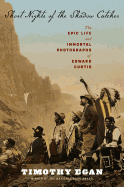
Timothy Egan's Short Nights of the Shadow Catcher, his biography of the photographer Edward Curtis (1868-1952), mesmerizes--it's instructive, entertaining and a joy to read.
In the late 19th century, Curtis had a successful photography studio in Seattle. The last surviving daughter of Si'ahl, the Native American chief who gave the city its name, lived there, too, and once Curtis found out about her, he took her picture. From then on, he became determined to find more Native Americans to photograph.
One day, he came across a lost hiking party on Mt. Rainier and led them to safety. One of the hikers was C. Hart Merriam, co-founder of the National Geographic Society, who invited Curtis to join him as the photographer on a voyage to Alaska. Curtis took 5,000 gorgeous photographs, many of Native Americans, using a laborious photogravure process in which the image was chemically etched onto the surface of a copper printing plate.
He now saw his life's work as photographing as many Native Americans as he could; thus was born the 20-volume The North American Indian. Although Curtis was criticized by some for "staging" his photos, he always wanted them to be as authentic as possible. When it was completed, his magnum opus compiled more than 1,500 photogravure plates of Indians from roughly 80 tribes. Yet fewer than 500 copies were printed, and complete, uncut sets are now worth millions.
The adjectives Egan uses in his subtitle--epic, immortal--set the bar high, but he clears it with ease. When it comes to historical writing, this is as good as it gets. --Tom Lavoie, former publisher

